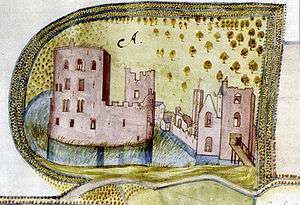Teylingen Castle
| Teylingen Castle | |
|---|---|
| Slot Teylingen | |
| Voorhout, the Netherlands | |
|
Teylingen castle in 2007 | |
|
The oldest picture of the castle; a drawing by Symon Aerntszoon van Buningen | |
 Teylingen Castle | |
| Coordinates | 52°13′52″N 4°31′9″E / 52.23111°N 4.51917°E |
| Type | Castle |
| Site information | |
| Owner | Dutch Government |
| Open to the public | Yes |
| Condition | Ruin |
| Site history | |
| Built | 13th century |
| Materials | Brick |
Teylingen Castle (Dutch: Slot Teylingen) is a Dutch castle in the municipality of Teylingen, in Voorhout, near the border with Sassenheim. It is presumably the family keep of the noble family Van Teylingen, from which the Van Brederode family directly descended.
The castle was originally built to protect the north-south route in Hollandic territory. Later it became a forester's castle for the forestry of the counts of Holland, starting with William IV, count of Holland.
One of the best known inhabitants of the castle was Jacoba of Bavaria, who died there, and her fourth husband Frank van Borssele. The drinking cups that have been dug up in the surrounding area are called Jacobakanntjes.
At present, only ruins are left of the castle. These ruins are, however, well preserved, existing out of a surrounding wall and a donjon which forms part of the wall, and which is partially surrounded by water. The wall dates from the start of the 13th century and the main building shortly thereafter. The castle was heavily damaged around 1570 in the Eighty Years' War, and partially restored after that. Around 1675 the donjon was burned in a fire, after which decay set it, and parts were gradually demolished. The lands (and the ruins) were possessions of the province of Holland, and were nationalised in 1795. Shortly after the complex was sold, under the condition that the ruins would not be demolished, which made the ruins an early example of the Dutch monumental care. In 1889, the ruins were donated by Jhr. Mr. W. van Teylingen back to the Dutch state, who still owns them. The ruins are under the care of the Rijksgebouwendienst (state's building service). At the end of the 20th century, the ruins were restored and the moat, which had been partially filled, was restored as well. This was made possible by the purchase of grounds by the Foundation Slot Teylingen (with support of the Prins Bernhard Cultuurfonds), who donated the acquired grounds to the Dutch state.
The municipality Teylingen is named after the castle, partly because the name Teylingen was also present in the three former municipalities Sassenheim, Voorhout and Warmond.
Television
In the series Bassie and Adriaan and De verdwenen kroon (1988), the villains hid in the castle, and the castle was filmed extensively for the series.

